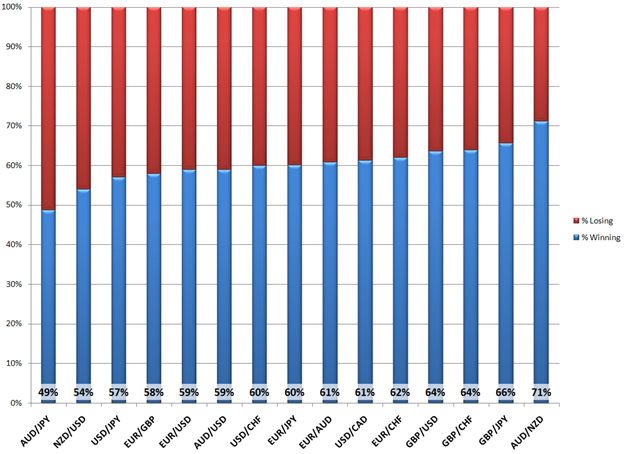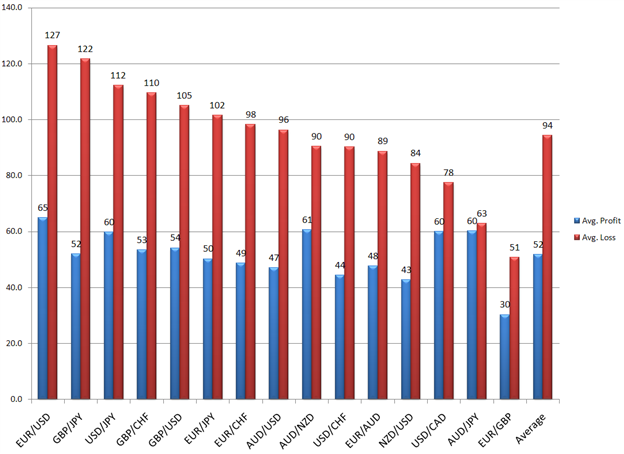Why Do Many Forex Traders Lose Money?
In our Traits of Successful Traders series, the
DailyFX Research and Education teams go through a year’s worth of trades
from actual clients and discusses the results along with surprising
conclusions.
Strong growth in forex trading has brought a
significant increase in the number of new traders, but the influx has
been matched by a similar outflow of existing traders. Why? This article
discusses arguably the most important question of all – why do many
forex traders lose money?
Why Does the Average Forex Trader Lose Money?
Many forex traders have significant experience
trading in other markets, and their technical and fundamental analysis
is often quite good. In fact, in almost all of the most popular currency
pairs that FXCM clients trade, traders are correct more than 50% of the time:

The above chart shows the results of a data set of
over 12 million real trades conducted by FXCM clients worldwide in 2009
and 2010. It shows the 15 most popular currency pairs that clients
trade. The blue bar shows the percentage of trades that ended with a
profit for the client. Red shows the percentage of trades that ended in
loss. For example, in EUR/USD, the most popular currency pair, FXCM
clients in the sample were profitable on 59% of their trades, and lost
on 41% of their trades.
So if traders tend to be right more than half the time, why do most forex traders lose money?

The above chart says it all. In blue, it shows the
average number of pips traders earned on profitable trades. In red, it
shows the average number of pips lost in losing trades. We can now
clearly see why traders lose money despite bring right more than half
the time. They lose more money or their losing trades than they make on their winning trades.
Let’s use EUR/USD as an example. We know that
EUR/USD trades were profitable 59% of the time, but trader losses on
EUR/USD were an average of 127 pips while profits were only an average
of 65 pips. While traders were correct more than half the time, they
lost nearly twice as much on their losing trades as they won on winning trades losing money overall.
The track record for the often-volatile
GBP/JPY pair was even worse. Traders were right an impressive 66% of
the time in GBP/JPY – that’s twice as many successful trades as
unsuccessful ones. However, traders overall lost money in GBP/JPY
because they made an average of only 52 pips on winning trades, while
losing more than twice that – an average 122 pips – on losing trades.
Cut Your Losses Early, Let Your Profits Run
Countless trading books advise traders to do this. When your trade goes against you, close it out. This is difficult to do because it is going against the great deal of work and research you performed to first enter the trade. Closing it out at a loss is admission that you were wrong—invalidating everything you did that went into that trade.
Worse than admitting you’re wrong, however, is letting a small loss balloon into a large one.
This is exactly the mistake we watch time and time again: traders are
too willing to hold onto a losing trade in the hopes that it will come
back. And to be clear, a trade can come back and there will definitely
be times that you will have avoided a loss by holding onto a small
loser. But those large losses completely ruin the potential reward on
your overall trading.
Conversely, when a trade is going well, do not be afraid to let it continue working. You may be able to gain more profits.
After taking a series of losses or perhaps one especially large loss,
it is natural for us to take profits on a trade due to fears that it can
go against us. Taking profits also proves that we were right—the hard
work that went into the trade was valid and it feels good. Yet letting losses run and cutting profits short is how many traders lose money.
How to Do It: Follow One Simple Rule
Avoiding the loss-making problem described above is pretty simple
in theory, though it is admittedly difficult in practice. When trading,
one rule is critical: always seek trades that offer larger potential
rewards than losses. This is nothing groundbreaking, and almost every
trading book will tell you the same thing.
Typically, this is called a “reward/risk ratio”.
If your analysis shows that a trade will pay out 100 pips with a max
risk of 100 pips, your reward/risk ratio is 1 to 1. If you risk losing
200 pips to make that same 100, then that same ratio is 1:2.
According to our data on real traders, the average
reward/risk on EURUSD trades was 127 pips in average losses versus 65
pips in gains—approximately 1:2.Given that reward/risk, traders would
have had to make profits on at least 66 percent of all trades to
ultimately make money. Unfortunately the true win percentage was 57
percent and helps explain why most lost.
You should always use a minimum 1:1 ratio.
That way, if you are right only half the time, you
will at least break even. Generally, with high probability trading
strategies, such as range trading strategies, you will want to use a
lower ratio, perhaps between 1:1 and 2:1. For lower probability trades,
such as trend trading strategies, a higher reward/risk ratio is recommended, such as 2:1, 3:1, or even 4:1. Remember, the higher the reward/risk ratio you choose, the less often you need to be right in order to make money trading.
Stick to Your Plan: Use Stops and Limits
Once you have a trading plan that uses a proper reward/risk ratio, the next challenge is to stick to the plan. Remember, it is natural for us
to want to hold on to losses and take profits early, but it makes for
bad trading. We must overcome this natural tendency and remove our
emotions from trading.
The best way to do this is to set up your trade with Stop-Loss and Limit orders from the beginning.
This will allow you to use the proper reward/risk ratio (1:1 or higher) from the outset, and to stick to it. Once you set them, don’t touch them (One exception: you can move your stop in your favor to lock in profits as the market moves in your favor).
Culled from xe.com
Thank you!
ReplyDelete